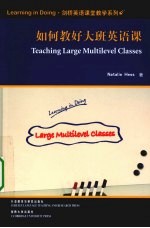

如何教好大班英语课PDF电子书下载
- 电子书积分:9 积分如何计算积分?
- 作 者:(美)赫斯著
- 出 版 社:北京:外语教学与研究出版社
- 出版年份:2009
- ISBN:9787560088587
- 页数:197 页
Introduction 1
How to make best use of this book 1
What is a large multilevel class? 1
Benefits and challenges of the large multilevel class 2
Eleven principles of coping in large multilevel classes 7
1 Getting to know our students 16
Learning their names 16
1.1 Name toss 17
1.2 Picture it 18
1.3 Names as crosswords 19
1.4 The story ofmy name 20
1.5 Names and adjectives 21
1.6 I am and I love 22
1.7 Desk placards 22
1.8 Use real pictures 23
Learning about our students'lives 24
1.9 The letter 24
1.10 Guess who? 26
1.11 Three things about me 27
1.12 Mutual interviews 28
1.13 The missing person announcement 29
1.14 Managing my time 31
1.15 Formal introductions 32
2 Motivation and activation 34
2.1 Burst the balloon-expressing opinions 35
2.2 The preference line-explaining yourself 38
2.3 The quick-write 39
2.4 Like,dislike,or neutral 40
2.5 What's your number? 41
2.6 Again and again and again 43
2.7 Friendship 44
2.8 More about friendship 45
2.9 People I admire 46
2.10 Special places 47
2.11 Dreams I have 48
2.12 How I feel now 49
2.13 Slip exchange 50
2.14 Flip-flop books 51
2.15 Frame it 53
2.16 Colored round robin 54
2.17 Circle talk 55
2.18 Teaming up 57
2.19 Needle in a haystack 57
2.20 Optimistic snapshots 58
2.21 Words on cards 58
2.22 A solution for the problem 59
2.23 Student-centered dictation 59
2.24 The seminar 60
3 Reviewing while maintaining interest and momentum 62
3.1 Answers into questions 63
3.2 Review posters 64
3.3 Student-made quickie quizzes 65
3.4 Group reviews 66
3.5 Group summaries 67
3.6 Vocabulary wall 68
3.7 Class goals 68
3.8 The KWL procedure 69
3.9 The Venn diagram 71
3.10 Judging people 72
3.11 Running dictation 73
3.12 My sentence 74
3.13 Where is my other half? 75
3.14 Person,place or thing 75
4 Dealing with written work 77
4.1 Keep it going 80
4.2 Peer reviews 81
4.3 Writing conferences 83
4.4 Write before you talk 85
4.5 Buddy journals 86
4.6 Using email 87
4.7 Wall newspaper 88
4.8 Using chat rooms 89
4.9 Using websites 90
4.10 Writing about landscape pictures 91
4.11 Writing about pictures of people 1 92
4.12 Writing about pictures of people 2 93
4.13 Service writing 94
4.14 A bio-poem class book 95
4.15 The cumulative folder 97
4.16 Sentences into story 98
4.17 Personalized guide books 98
4.18 Change the audience 100
4.19 Clustering 102
4.20 The writing cycle 103
4.21 A resource for self-correction 104
4.22 Letters of advice 105
4.23 In the middle of the story 106
4.24 The spelling list 109
4.25 From words to story 110
4.26 Plot construction 111
5 Working well in groups 112
5.1 Working together 115
5.2 The quiet signal 116
5.3 Give me your sticks 118
5.4 The text jigsaw 119
5.5 The picture jigsaw 121
5.6 Making mine long 122
5.7 Sentences into story 123
5.8 The aquarium 124
5.9 All for one 125
5.10 Group dictations 126
5.11 The community group project 127
5.12 The walk-about 129
5.13 Picture puzzle 130
5.14 Back and forth movie preview/in view 131
5.15 Three in one 131
5.16 The missing word 132
5.17 Alphabet shopping 133
5.18 Pronoun search 133
5.19 Words to make a cake 134
5.20 Things we share 135
5.21 Our group cheer 135
5.22 Dictated stories 136
5.23 Three good questions 136
6 Individualizing and personalizing student work 137
Individualizing 138
6.1 Multilevel dictation 138
6.2 The book cart 139
6.3 Silent task work with a self-access box 140
6.4 Working with words 142
6.5 Sentence completion 143
6.6 Question the reading 143
Personalizing 144
6.7 Vocabulary cards 144
6.8 Three-minute talks 145
6.9 The story of my life posters 146
6.10 My object 148
6.11 The vocabulary house 149
6.12 The mailbox 150
6.13 My machine 151
6.14 An important decision 152
6.15 An important sentence 152
6.16 Color sadness blue 153
6.17 Water words 153
6.18 I don't like people who 154
6.19 Careers in my family 155
6.20 What we want from our work 155
6.21 Our own good folder 156
6.22 Words on my desk 157
6.23 Drawing interpretation 157
7 Making students responsible for their own learning 159
7.1 What kind of a learner am I? 160
7.2 Setting goals for myself 161
7.3 How a teacher helped me 162
7.4 How can the teacher help me? 163
7.5 How I can help myself 164
7.6 Personal conferences 165
7.7 What kind of a listener am I? 166
7.8 This course will be a success for me if... 169
7.9 What kind of a reader am I? 169
7.10 Am I brave enough? 171
7.11 Question posters 172
7.12 How do I catch and correct my own mistakes? 173
7.13 Instant answers 174
7.14 Words from the world 175
7.15 Questions on a stick 175
7.16 Many ways to be smart 176
7.17 Grade contracts 178
7.18 Self-check forms 180
8 Establishing routines and procedures 182
8.1 Introducing the class syllabus 183
8.2 Setting up the class calendar 185
8.3 Checking homework,tardiness,and attendance 186
8.4 The daily plan 187
8.5 The absent student notebook 188
8.6 Exit notes 188
Class rituals 189
8.7 Lesson starters 189
8.8 Today's special student 190
8.9 Celebrating birthdays 191
8.10 The complaint/suggestion/compliment box 192
8.11 Elves and giants:an occasional on-going ritual 193
Bibliography 194
Index 196
- 《高级英语阅读与听说教程》刘秀梅编著 2019
- 《思维导图 超好用英语单词书》(中国)王若琳 2019
- 《初中生英语作文 提高篇》清瑶主编 2019
- 《培生高级英语语法 练习册》培生教育 2019
- 《指向核心素养 北京十一学校名师教学设计 英语 七年级 上 配人教版》周志英总主编 2019
- 《365奇趣英语乐园 世界民间故事》爱思得图书国际企业 2018
- 《新课标背景下英语教学理论与教学活动研究》应丽君 2018
- 《幼儿英语游戏活动指导与实训》苏小菊,任晓琴主编;颜晓芳,覃静,谢恬恬,钟博维副主编 2020
- 《剑桥国际英语写作教程 段落写作》(美)吉尔·辛格尔顿(Jill Shingleton)编著 2019
- 《大学英语四级考试全真试题 标准模拟 四级》汪开虎主编 2012
